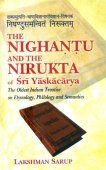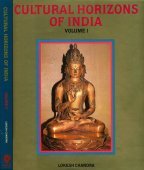Etymology: 1 definition
Introduction:
Etymology means something in Hinduism, Sanskrit. If you want to know the exact meaning, history, etymology or English translation of this term then check out the descriptions on this page. Add your comment or reference to a book if you want to contribute to this summary article.
In Hinduism
Purana and Itihasa (epic history)
Source: Shodhganga: Elements of Art and Architecture in the Trtiyakhanda of the VisnudharmottarapuranaKnowledge of Etymology (in Sanskrit: Mānasī) was considered one of the “sixty four kinds of Art”, according to the Kamasutra of Vatsyayana.—Indian tradition, basically includes sixty four Art forms are acknowledged. The history of Indian Art covers approximately five thousand years which presents a rich and almost continuous record. The references of sixty four kinds of Kala (कला, kalā) are found in the Bhagavatapurana, Shaiva-Tantras, Kamasutra of Vatsyayana etc.

The Purana (पुराण, purāṇas) refers to Sanskrit literature preserving ancient India’s vast cultural history, including historical legends, religious ceremonies, various arts and sciences. The eighteen mahapuranas total over 400,000 shlokas (metrical couplets) and date to at least several centuries BCE.
See also (Relevant definitions)
Query error!
Full-text (+501): Vyutpatti, Nirvacana, Nirukta, Yaugika, Nairukta, Padabhanjana, Anvartha, Nirvachan, Vedanga, Vyakaranaprakriya, Nirukti, Vyutpattishastra, Yaska, Ind, Yogashabda, Nipata, Vastya, Shabdasadhanavidya, Avyutpatti, Shabdavyutpatti.
Relevant text
Search found 193 books and stories containing Etymology; (plurals include: Etymologies). You can also click to the full overview containing English textual excerpts. Below are direct links for the most relevant articles:
Hindu Pluralism (by Elaine M. Fisher)
The Many Meanings of Nārāyaṇa < [Chapter 3 - Constructing Sectarian Identities in Early Modern South India]
Philology and Public Religious Culture < [Chapter 3 - Constructing Sectarian Identities in Early Modern South India]
Theology beyond the Text < [Chapter 3 - Constructing Sectarian Identities in Early Modern South India]
Svacchandatantra (history and structure) (by William James Arraj)
2.3 Commentatorial Techniques < [Introduction]
2.4 Harmonization and Commentatorial Goals < [Introduction]
New Burushaski etymologies: origins of Burúśo and Miśáski. < [Volume 79 (2018)]
Chinese origin of the term pagoda: Liang Sicheng’s proposed etymology < [Volume 77 (2016)]
Evidence for a Burushaski-Phrygian connection < [Volume 75 (2014)]
Dhammapada (translated from the Pali) (by F. Max Müller)
Nighantu (critical study) (by Gopalakrishna N. Bhat)
Bhagavata Purana (by G. V. Tagare)
Popular etymologies of ‘Nārāyaṇa’ < [Appendices]
Chapter 13 - The Description of the Race of Nimi < [Book 9 - Ninth Skandha]
Notes regarding the words (verbal nature) of Śruti (the Vedas) < [Appendices]
Related products

